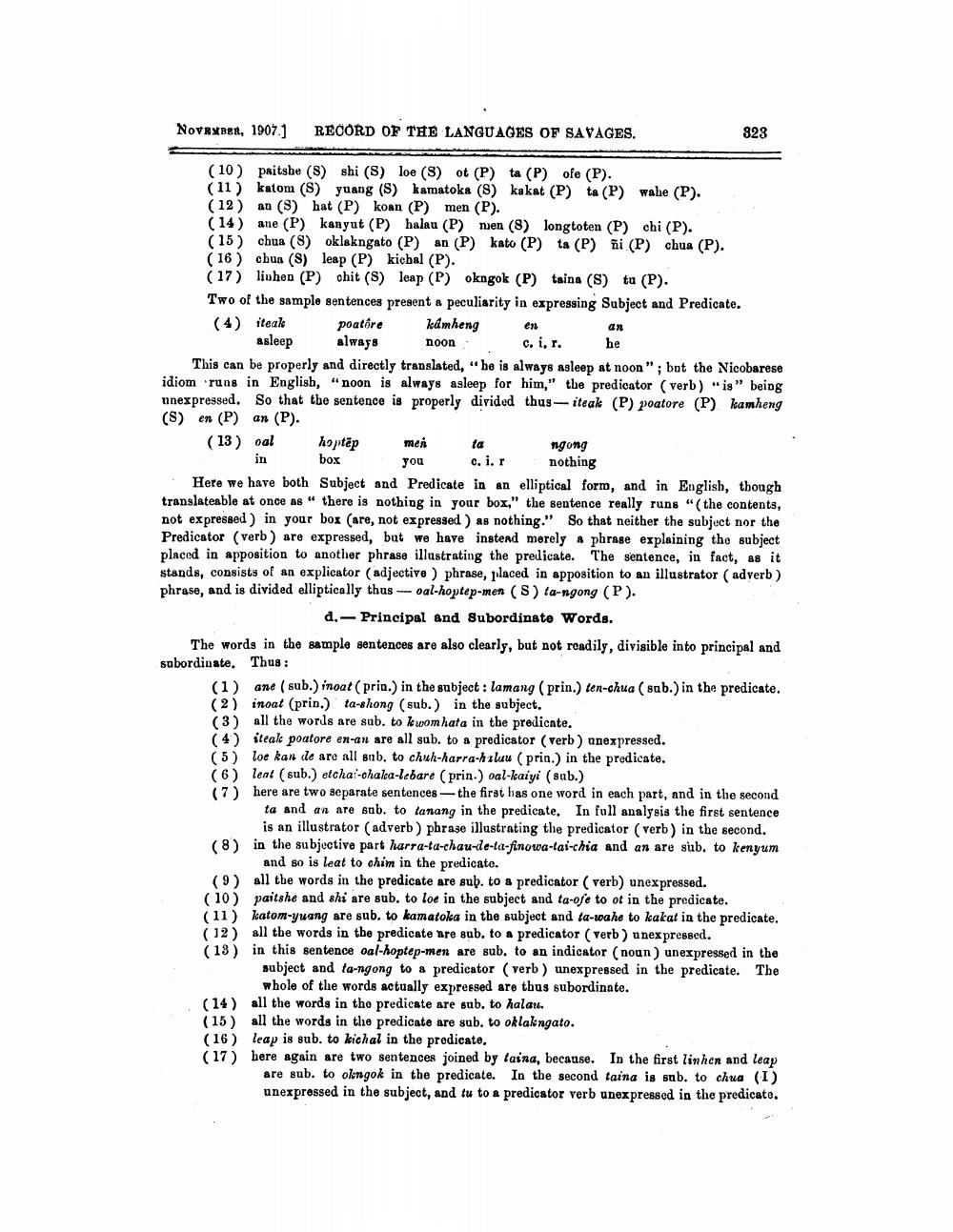________________
November, 1907.)
RECORD OF THE LANGUAGES OF SAVAGES.
823
(10) paitsbe (S) shi (8) loe (8) ot (P) ta (P) Ofe (P). (11) katom (S) yuang (8) kamatoka (8) kakat (P) ta (P) wabe (P). (12) an (S) hat (P) koan (P) men (P). (14) ane (P) kanyut (P) halau (P) men (8) longtoten (P) chi (P). (15) chua (8) oklakngato (P) an (P) kato (P) ta (P) ñi (P) chua (P). ( 16 ) chua (8) leap (P) kichal (P). (17) livhen (P) chit (8) leap (P) okngok (P) taina (8) tu (P). Two of the sample sentences present a peculiarity in expressing Subject and Predicate. (4) iteak poatôre kamheng en
an asleep
always noon c.i.r. he This can be properly and directly translated," he is always asleep at noon"; but the Nicobarese idiom runs in English, "noon is always asleep for him," the predicator (verb)" is" being nnexpressed. So that the sentence is properly divided thus-iteak (P) poatore (P) kamheng (8) en (P) an (P). (13) oal hoptep mei t a
ngong box
you c. i. r nothing Here we have both Subject and Predicate in an elliptical form, and in English, though translateable at once as there is nothing in your box," the sentence really runs "(the contents, not expressed in your box (are, not expressed ) as nothing." So that neither the subject nor the Predicator (verb) are expressed, but we have instead merely & phrase explaining the subject placed in apposition to another phrase illustrating the predicate. The sentence, in fact, as it stands, consists of an explicator (adjective ) phrase, pilaced in apposition to an illustrator (adverb) phrase, and is divided elliptically thus - oal-hoptep-men (S) ta-ngong (P).
d. - Principal and Subordinate Words. The words in the sample sentences are also clearly, but not readily, divisible into principal and subordinate. Thus :
(1) ane (sub.) inoat (prin.) in the subject : lamang (prin.) ten-chua (sab.) in the predicate. (2) inoat (prin.) ta-shong (sub.) in the subject. (3) all the words are sub. to kwomhata in the predicnte. (4) steal poatore en-an are all sub. to a predicator (verb) unexpressed. (5) loe kan de are all sub, to chuh-harra-hiluu (prin.) in the predicate. (6) lent (sub.) etcha-chala-lebare (prin.) oal-kaiyi (sab.) (7) here are two separate sentonces the first has one word in each part, and in the second
ta and an are sab. to tanang in the predicate. In full analysis the first sentence
is an illustrator (adverb) phrase illustrating the predicator (verb) in the second. (8) in the subjective part harra-ta-chau-de-la-finowa-lai-chia and an are sub. to kenyum
and so is leat to chim in the predicato. (9) all the words in the predicate are sub. to a predicator (verb) unexpressed. (10) paitshe and shi are sub. to loe in the subject and ta-ofe to ot in the predicate. (11) katom-yuang are sub. to kamatoka in the subject and ta-wahe to kakat in the predicate. (12) all the words in the predicate are sub, to a predicator (verb) unexpressed. (13) in this sentence oal-hoptep-men are sub. to an indicator (noun) unexpressed in the
subject and ta-ngong to a predicator ( verb ) unexpressed in the predicate. The
whole of the words actually expressed are thus subordinate. (14) all the words in the predicate are sub, to halau. (15) all the words in the predicate are sub. to oklak ngato. (16) leap is sub. to kichal in the prodicate, (17) here again are two sentences joined by taina, because. In the first linhen and leap
are sub. to okngok in the predicate. In the second taina is sub. to chua (I) unexpressed in the subject, and tu to a predicator verb unexpressed in the predicate.




